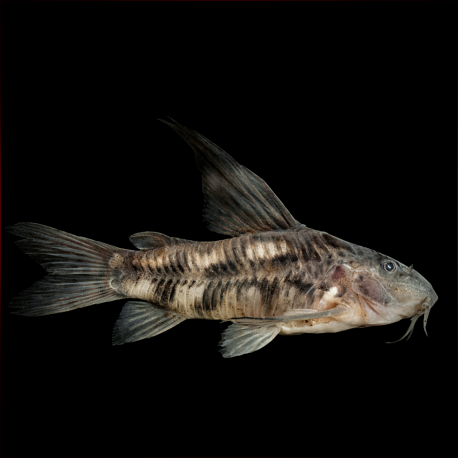More info
Datasheet
| Minimum Tank Size | 270 litres / 71.33 US gallons |
| Maximum Size | 9.0cm / 3.54inches |
| Temperature | 14°C / 57.20°F - 20°C / 68.00°F |
| Hardness | 1.01dgH / 18ppm - 8.01dgH / 143ppm |
| pH | 5.0-7.0 |
General Description
Scleromystax Macropterus, commonly known as Sailfin 'Cory', belongs to the Callichthyidae family of the order Siluriformes. These fish are part of the group referred to as 'armoured' or 'mailed' catfishes due to the bony plates on their body. They are facultative air breathers having evolved to intake atmospheric oxygen, seen occasionally rising to the aquarium surface for air. With stiff pectoral-fin spines that can cause painful stings, handling them requires care.
Aquarium Setup
For Sailfin 'Cory', a tank size of at least 270 litres is recommended with a substrate of fine sand or clean rounded gravel. Providing adequate cover is essential, especially when housing multiple males. The water conditions should ideally maintain a hardness of 18-143ppm, pH levels of 5.0-7.0, and a temperature range of 14-20°C.
Behaviour
These fish exhibit some territorial behavior amongst males, hence it is advised to avoid keeping them together in smaller tanks. Otherwise, they are generally peaceful within the aquarium environment.
Feeding and Diet
Scleromystax Macropterus are omnivores that accept a variety of sinking dried foods, alongside small live and frozen options like chironomid larvae and Tubifex. A diverse diet ensures their optimal health, as they should not solely rely on leftovers or aquarium 'cleaning' duties.
Reproduction & Dimorphism
Breeding Sailfin 'Cory' is similar to other Corydoras species, preferring a male-to-female ratio to prevent male aggression during spawning. The eggs are usually laid on aquarium glass or in vegetation, and successful breeding requires meticulous care of water quality and appropriate food for the fry. Males are more striking in appearance with longer fins compared to females.
Habitat and Distribution
These catfish are mainly found in small blackwater streams that drain into the Atlantic Ocean, but they are also known to inhabit roadside ditches and similar environments. Their natural distribution includes the coastal states of southern Brazil and some tributaries in Paraguay.

